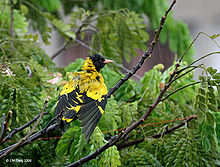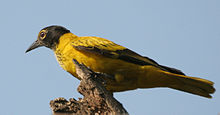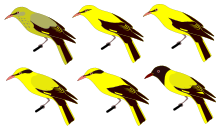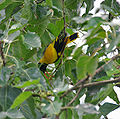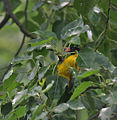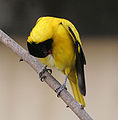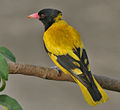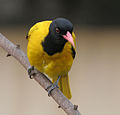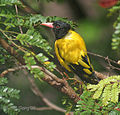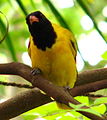- Black-hooded Oriole
-
Black-hooded Oriole 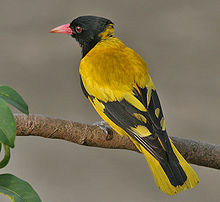
Conservation status Scientific classification Kingdom: Animalia Phylum: Chordata Class: Aves Order: Passeriformes Family: Oriolidae Genus: Oriolus Species: O. xanthornus Binomial name Oriolus xanthornus
(Linnaeus, 1758)The Black-hooded Oriole, Oriolus xanthornus, is a member of the oriole family of passerine birds and is a resident breeder in tropical southern Asia from India and Sri Lanka east to Indonesia.
It is a bird of open woodland and cultivation. The nest is built in a tree, and contains two eggs. The food is insects and fruit, especially figs, found in the tree canopies where the orioles spend much of their time.
The male is striking, with the typical oriole black and yellow coloration. The plumage is predominantly yellow, with a solid black hood, and black also in the wings and tail centre.
The female Black-hooded Oriole is a drabber bird with greenish underparts, but still has the black hood. Young birds are like the female, but have dark streaking on the underparts, and their hood is not solidly black, especially on the throat.
The black head of this species is an obvious distinction from Golden Oriole, Oriolus oriolus, which is a summer visitor to northern India. Orioles can be shy, and even the male may be difficult to see in the dappled yellow and green leaves of the canopy.
The Black-hooded Oriole's flight is somewhat like a thrush, strong and direct with some shallow dips over longer distances.
The New World orioles are similar in appearance to the Oriolidae, but are icterids unrelated to the Old World birds.
In Culture
In Sri Lanka, this bird is known as Kaha Kurulla (translates to 'yellow bird') in Sinhala Language[1] In Bangladesh, this bird is known as Bene Bou or Krishno Kotha Pakhi(translates to 'বেনেবউ বা কৃষ্ণ কোথা পাখি বা হলদে পাখি') in Bangla Language
References
- BirdLife International (2004). Oriolus xanthornus. 2006. IUCN Red List of Threatened Species. IUCN 2006. www.iucnredlist.org. Retrieved on 12 May 2006. Database entry includes justification for why this species is of least concern
- Birds of The Gambia by Barlow, Wacher and Disley, ISBN 1-873403-32-1
Gallery
-
catching insects on Kapok Ceiba pentandra in Kolkata, West Bengal, India.
-
on Kapok Ceiba pentandra in Kolkata, West Bengal, India.
-
catching insects on Kapok Ceiba pentandra in Kolkata, West Bengal, India.
-
eating Peepal fig in Kolkata, West Bengal, India.
-
eating Peepal fig in Kolkata, West Bengal, India.
-
nest in Kolkata, West Bengal, India.
-
preening in Kolkata, West Bengal, India.
-
In Kolkata, West Bengal, India.
-
In Kolkata, West Bengal, India.
-
In Kolkata, West Bengal, India.
-
In Kolkata, West Bengal, India.
-
Calling & in display in Kolkata, West Bengal, India.
-
Preening in Kolkata, West Bengal, India.
-
in Kolkata, West Bengal, India.
-
in Kolkata, West Bengal, India.
-
in Kolkata, West Bengal, India.
-
in Kolkata, West Bengal, India.
-
After bath in the rain in Kolkata, West Bengal, India.
-
Immature in Kolkata, West Bengal, India.
Categories:- IUCN Red List least concern species
- Oriolus
- Birds of Pakistan
- Birds of India
- Birds of Bangladesh
- Birds of Sri Lanka
Wikimedia Foundation. 2010.


